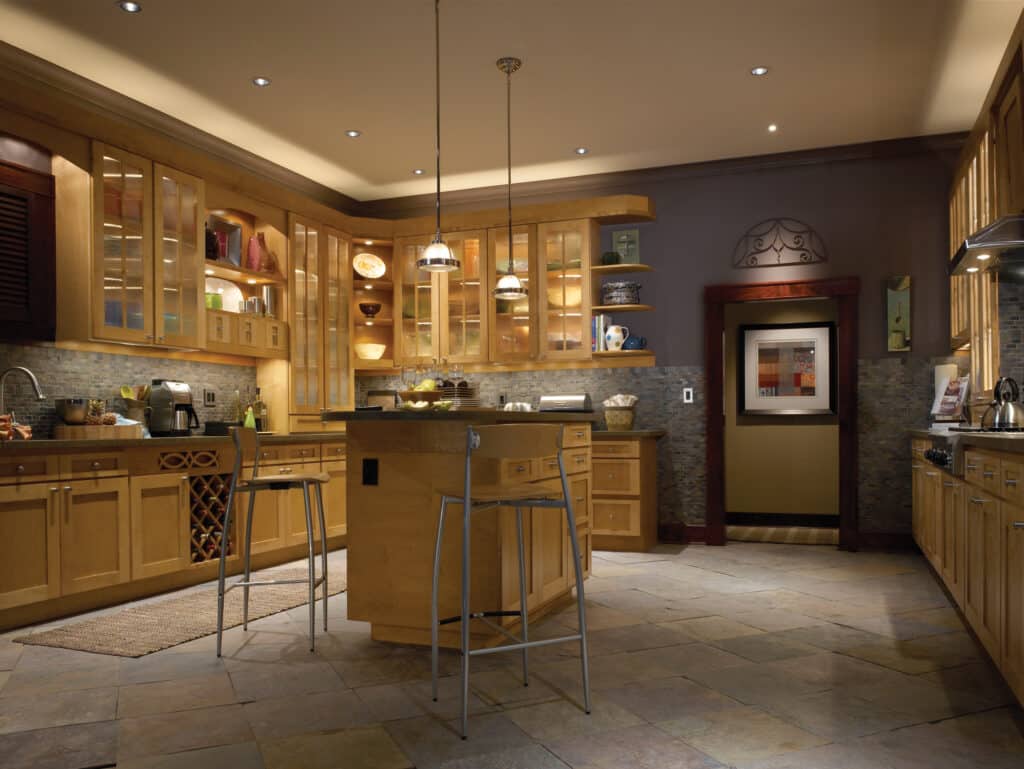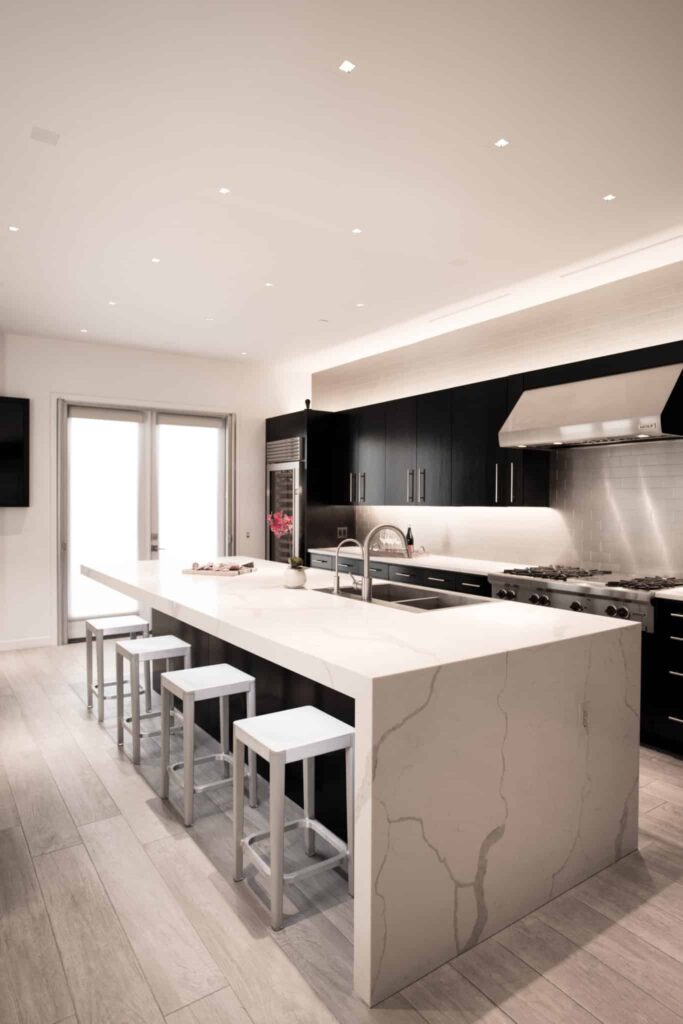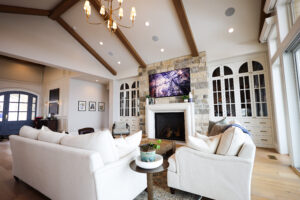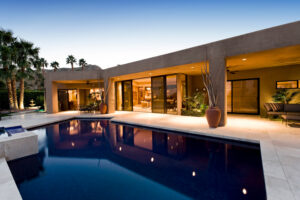Eco-smart homes are in demand now more than ever because investing in green technology for homes benefits both homeowners and the environment. From lowering energy bills to decreasing carbon footprints, integrating smart home technology is the way of the future.
Below we’ll break down the benefits of eco-friendly home automation with the best systems and features to look for. Whether you’re building a new home or retrofitting, here’s how to make your house more sustainable with home automation.
What are eco-smart homes?
A sustainable home is designed to be efficient, eco-friendly, and smart. It typically incorporates sustainable materials and smart home technology to reduce its environmental impact while making everyday life more convenient with home automation.
These homes are becoming increasingly popular as homeowners look for ways to save energy, cut costs, and simplify their routines. With features like automated lighting, energy monitoring, and temperature control, eco-smart homes blend sustainability with modern comfort.
Below we’ll break down some smart home benefits of sustainable technology for homeowners.
Wired vs. Wireless Integration for Eco-Smart Homes
If you’re considering building or retrofitting it into an eco-smart home, ensure to get it integrated with a wired connection. A wired integration is hardwired and hidden through the home’s wall or ceilings to provide the best connection to all smart home devices.
When integrating smart home technology, we always recommend wired integration over wireless. There are many benefits of wired home automation, including a stronger internet connection, secure networking, and practicality for larger homes.
| Wired Smart Home Integration | Wireless Smart Home Integration |
| Ethernet connection eliminates interference | Wi-Fi connection subject to interference |
| Ideal for large homes | Best for individual rooms or small homes |
| More secure networking from hackers | Less secure networking from hackers |
| Higher costs | Lower costs |
| Requires professional installation and repairs | Easier to maintain and fix minor issues |
| Less flexible location (hardwired) | Flexible placement location (router) |
Wireless integration has a less stable internet connection because it’s subject to interference, especially if many smart devices are connected. Its signals must pass through walls and other objects, which can block them from communicating with the sensors and smart home technology — while wired smart homes use an ethernet cable to eliminate electrical interference.
Although wireless integrations have less upfront costs, wired integrations provide the best possible results for homeowners considering sustainable smart home technology.
4 Benefits of Eco Smart-Homes for Homeowners
Sustainable home automation offers many advantages for homeowners, such as energy cost savings and less environmental impact. Now that you know what eco-smart homes are and how to integrate them, we’ll break down four benefits of investing in green technology for homes below.
1. Green Technology for Homes Decreases Environmental Impact
The most apparent benefit of eco-friendly home technology is its environmental impact. Smart sustainable homes are designed with automated technology to be more energy efficient. According to Forbes, a study found that home automation can save up to 12.78% of carbon emissions. From lowering electricity consumption to minimizing water use, homeowners can reduce their carbon footprint with smart home technology.
2. Sustainable Homes Can Lower Energy Bills
Smart lights and dimmers are a game-changer for homeowners looking to cut down on energy bills—offering up to 40% savings on energy costs. Thanks to their use of energy-efficient small aperture LED lighting, they consume far less power than traditional incandescent lights.
But it’s not just about the LEDs. Smart lighting systems offer multiple features that help reduce energy usage, such as:
- Energy-efficient LEDs that provide bright illumination while using less power.
- Dimmers that let you adjust light output to fit your needs.
- Pre-set schedules to limit artificial light use when it’s not needed.
- Motion sensors to ensure lights only turn on when someone’s there.
- Remote control through smart devices or home panels to switch off lights accidentally left on.
By combining efficiency with convenience, smart lights make it easy for homeowners to save energy without sacrificing comfort or style.
3. People Living in Sustainable Smart Homes Promote More Sustainable Behaviors
Arguably the best benefit of green technology for homes is its lifestyle and cultural impact on the environment. Studies show that smart home technology promotes more sustainable behaviors from people who own them.
Additionally, since smart home consumers are shown to become more environmentally aware, they’re more likely to recommend smart home adoption to people they know. These cultural shifts raise sustainability awareness and encourage greener lifestyle changes which can benefit the environment significantly.
4. Pre-Integrated Smart Homes Have Higher Resale Value
Did you know that homes pre-integrated with smart home technology have a higher resale value? Recent studies found that 81% of homebuyers are more likely to purchase a new smart home, and many are willing to pay more.
Current smart home real estate demands are trending for added lifestyle convenience, sustainability benefits, and home security installation. Homebuyers and appraisers consider these “move-in ready” home automation features as the most valuable property adjustments — which, in return, can increase your home’s resale value.
Eco-Friendly Home Technology & Automation Features We Recommend
Now that you know what eco-smart homes are and the many benefits they offer homeowners, here are our recommendations on the best green technology for homes from the AIS pros.
Low-Voltage Smart Lights to Save on Electricity Costs
For homeowners considering smart lights, use low-voltage lighting for the best sustainability benefits. Low-voltage lighting is lower than the standard 120 volts used in most homes and consumes less energy to illuminate. They’re more energy-efficient than conventional incandescent lighting and produce less heat, making them less likely to start house fires too.

Low-Voltage Lighting Recommendation: Lutron
Our brand recommendation for smart lights in sustainable homes is Lutron. Their LED smart lights have eco-friendly technology features, such as an average of 20% energy savings and possibly federal and state rebates qualifications.
At AIS, our low-voltage integrators install smart home lighting systems, including architectural lighting, multi-room, and whole-home lighting solutions. Ask us how we can help lower your home’s energy bills with smart lighting integration.
Motorized Shades to Minimize Artificial Light Usage and Control Indoor Climate
Motorized shades are essential in sustainable homes because they maximize natural light usage and help control indoor climates. Homeowners can remotely control their entire home’s window shading with motorized shades via a smart device or touch panel to minimize unnecessary artificial light usage.
Motorized shades can also help control energy usage inside the home too. They help keep warm air inside during the winter and cool air during the summer. By managing motorized shades with a click of a button, homeowners can lower their light and energy consumption with natural lighting and automated climate control.

Motorized Shades Recommendation: Lutron
In addition to smart lights, we recommend using Lutron for motorized shades to be more energy-efficient with your home’s lighting. Lutron offers a variety of high-end fabrics and color options to customize motorized shades with any aesthetic and protect your indoor furnishings from sunlight damage.
Smart Home Thermostats to Maximize Climate Control
Smart thermostats alone can save homeowners 10-30% on energy bills because of their automated features. Automating home climate control eliminates the need for manual setting and prevents overconsumption of energy.
Here are some sustainability features of smart home thermostats:
- Custom program set temperatures for workdays and weekend schedules
- Remote climate control access from a mobile app or home touch panel if you forget at home
- Automatic shut off if the door is left open
- Adjusts to heating/cooling settings to sudden weather changes
The energy-efficient features of a smart thermostat can make any home more sustainable.

Smart Home Thermostat Recommendations: 2GIG, ecobee, Honeywell
At AIS, the best smart home thermostat brands we regularly integrate and recommend are 2GIG, ecobee, and Honeywell — here’s why:
- 2GIG — compatible with most HVAC systems to reduce installation time and service calls
- ecobee — SmartSensor features to manage cold and hot spots in the home
- Honeywell — offers three preset temperature settings for easy energy saving
These high-quality smart thermostat brands are proven to save homeowners on energy costs while lowering their carbon footprint.
Smart Home Water Conservation Devices to Decrease Water Waste
In addition to energy efficiency, smart home technology can also help homeowners better manage water usage. Whether it’s devices for a smart bathroom or appliances for a smart kitchen, home automation can lower water waste. Below we’ll share some smart appliances and devices to automate water conservation in your kitchen and bathroom.

Smart Home Water Conservation Device Recommendations: Bathroom & Kitchen
Some smart home water conservation devices and brands we recommend are:
- Phyn Smart Water Assistant — kitchen and bathroom sink device to optimize water usage through device-specific insights, leak alerts, and repair issue notifications
- Moen Smart Shower Controller — smart shower head that sends smartphone notifications when the water temperature is set and pauses flow until you enter
- Charmingwater Touchless Bathroom Sink Smart Faucet — smart bathroom faucet with touchless sensors to stop water flow if no movement is detected
- Advanced Clean 100 SpaLet Bidet Toilet — smart toilet that minimizes toilet paper use through warm air dryer settings after bidet rinsing
Eco-friendly home technology makes it easy for homeowners to manage and minimize their water usage. It also provides many conveniences and benefits to streamline and enjoy your everyday routine and lifestyle.
Home Automation Control Systems to Manage Eco-Smart Homes Easily
With many sustainable smart home technologies available, managing them in one centralized place is essential for easy control. A home automation control system acts as a universal remote for smart home technology, devices, and equipment. Instead of managing multiple mobile applications or management systems for many smart devices, organize them in one place for easy eco-home control.

Home Automation Control System Recommendation: ELAN
Simply manage all eco-friendly home technology in one place via a home automation control system like ELAN. This high-end automation control system has face, hand, and close hand waving recognition, home floor plan views, and scalability to easily expand your smart home technology.
ELAN home control systems include high-end customization based on your unique home via an in-wall control system and mobile application. It’s also easy for builders to install with home automation professionals for new smart home builds.
Here are some of ELAN’s energy-efficient features for eco-smart homes:
- “Away” mode that conserves energy when no one is home (audio, lights, media, climate)
- Scheduling lighting system modes with customized brightness outputs
- Device-specific insights into climate history to track exact energy consumption
- Energy-smart climate and motorized shades control to optimize heating/cooling
- Solar panel monitoring and management
- Irrigation control that adjusts to the weather to prevent over-watering when it’s raining
Now that you know what eco-smart homes are and the benefits they provide homeowners, the next step is to get them installed by qualified system integrators.
At AIS, we’re proud to be certified by the Home Technology Association (HTA) to provide homeowners with the highest standards of home automation integration. When investing in green technology for homes, always get it installed by HTA-certified integrators to ensure the best possible results.
Make Your House More Sustainable Through Home Automation with AIS
Integrating sustainable smart home technology is a great return on investment because it benefits homeowners and the environment. It maximizes a home’s energy efficiency to lower living costs so you can enjoy a more comfortable home while reducing your carbon footprint.
If you’re interested in eco-smart homes and integrating sustainable home automation, use our budget calculator to plan, or contact us for help picking the best options today!



